Rip Van Winkle, Esq., wouldn't recognize his law firm today

Norm Tabler
I’ve been a lawyer for nearly half a century, always connected with the same law firm—as associate, partner, general counsel of a major client, back as counsel and now titled retired partner. Looking back, I see that the firm and law practice in general have changed profoundly over that period. But because the changes occurred over time, it was easy to miss them as they were happening. What if all the changes had been thrust upon me at once? What if, like Rip Van Winkle, I had fallen asleep in 1971, when I was admitted to the bar, and woken in 2019?
Rip Van Winkle woke with a start. Glancing at the clock, he was relieved to see that it was only 2 o’clock—just an hour since he’d fallen asleep. But as reassuring as the clock was, the calendar was alarming. The year was 2019. He’d slept 48 years!
His desk was the same, but where were his pen, legal pad and Rolodex? What was the television-like machine staring at him? Or the annoying little device in his hand ringing like a telephone?
What’s this building? He’d fallen asleep in a dowdy 1915-era building the firm had occupied since the Great Depression. This one was new and sleek. And according to the firm directory on his desk, it was but one of 14 offices scattered across the country and in England and China.
And the sheer number of people! The firm had been huge when he’d fallen asleep: one of the Big Three in the state, boasting 31 lawyers! But according to the directory on his desk, the firm now had 750 lawyers, give or take. A footnote explained that the number was approximate because lawyers come and go so fast.
Come and go? His firm’s lawyers didn’t come and go. They arrived directly from law school or clerkship, and if they made partner, they stayed until they retired or died.
Looking himself up in the firm directory, Rip noted an entry after his name: Health Law Practice Group. That was doubly puzzling. First of all, why was he assigned a specialty? A good lawyer ought to be able to do anything for a client—anything. That had been axiomatic when he’d fallen asleep. Second, what was health law? That was as alien as some of the other specialties, like environmental law.
He noticed the people walking by his office. They weren’t all white! Some were Asian-American; others were black; some looked Hispanic. When had that happened?
A substantial portion of them were women. At least that hadn’t changed! After all, somebody had to do the typing, run errands and make coffee for the lawyers. As one woman walked past, he summoned her into his office and asked if she was his secretary. She didn’t take it well. She informed him that she was a lawyer, and what’s more, a partner. Rip waited for the punchline. There wasn’t one.
It turned out that a substantial portion of lawyers, including partners, are women. Incoming associates are as likely to be women as men. Why not? Women now make up half of all law school students, and they outperform men academically.
As she left the room (somewhat huffily, Rip thought), she informed him that the firm no longer had secretaries. It had LAAs—legal administrative assistants. She advised him to seek advice from his own. When he did, the LAA showed him how to operate the machine on his desk, which was not a television after all, but a computer. And that ringing device in his hand? It was a phone, and—unless she was pulling his leg—it was smart.
When he turned his computer on (actually, the LAA did it), the firm’s home page was dominated by a report on him, Rip Van Winkle. It reported his hours, broken down by category, and fees in one way or another connected to him.
After the initial shock wore off, Rip felt a sense of familiarity. Sure, the detail of the report was new, but fundamentally it was the same as when he’d fallen asleep. It undertook to measure everything about his performance, but it reflected the same handicap as in the old days: The only two measuring sticks were hours and dollars.
The hours were broken down into five categories, starting with billable (nothing new there). And there were two columns for each category: actual and expected. The number in the expected billable column was high—significantly higher than when Rip had fallen asleep.
At first, Rip couldn’t square those high expected billable hours with the many dark offices and the fact that lawyers started leaving before it was even 5 in the afternoon! How could they meet their goals if they weren’t in the building that houses the library and the office phones?
With a little help from his LAA, he understood. Lawyers were able to work outside the building because the only tools they needed, a computer and phone (if it was smart) were portable. Lawyers could work anywhere, including home and Starbucks (whatever that was).
In addition to being able to work outside the office, today’s lawyers needed to do so. In the old days every lawyer was male, either single or with a wife who took care of all the demands of home and family. Not so in 2019, when half the lawyers were women, and virtually every spouse or life partner had a demanding job.
And those lawyers leaving before 5? It was probably their day to pick up the kids at day care.
Nostalgic for the old days, Rip journeyed to what had always been the heart of the firm: the library. He recalled that on a typical weekday and many Saturdays, every associate was in the library—sometimes all at the same time.
He recalled what was involved in legal research: leaving your office, taking the stairs or elevator to the library floor, searching for a book, taking it to a table or carrel, and thumbing through it. If you found the case you were looking for, you might photocopy it or, more likely, ask your secretary to do it. (You were supposed to reshelve the book, but you rarely did.)
On reflection, Rip could hardly believe that clients, who generally paid by the hour, could have afforded such a time-intensive exercise.
Now the library was empty and had been for years—more a museum of how law practice used to be than a place for legal research. But those volumes still looked great!
Back in his office, Rip reflected on his day and on a troubling paradox: Practicing in a firm of 750 lawyers was so much lonelier than practicing in a firm of 31 had been. Today each lawyer works alone at a computer, often nowhere near the office. The title of a best-seller from the 1950s came to mind: The Lonely Crowd. An aggregation of 750 lawyers certainly qualifies as a crowd, but that doesn’t stop those lawyers from being lonely.
As Rip prepared to leave for the day, he paused to reflect on the single most stunning revelation of a day chock-full of them: Men can type!
Norman Tabler is a retired partner with Faegre Baker Daniels.
ABAJournal.com is accepting queries for original, thoughtful, nonpromotional articles and commentary by unpaid contributors to run in the Your Voice section. Details and submission guidelines are posted at “Your Submissions, Your Voice.”
Your Voice submissions

The ABA Journal wants to host and facilitate conversations among lawyers about their profession. We are now accepting thoughtful, non-promotional articles and commentary by unpaid contributors.

